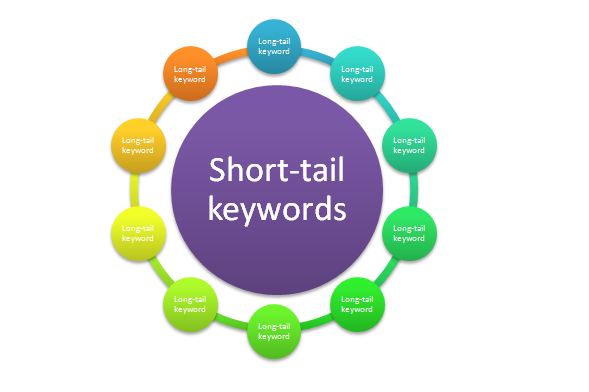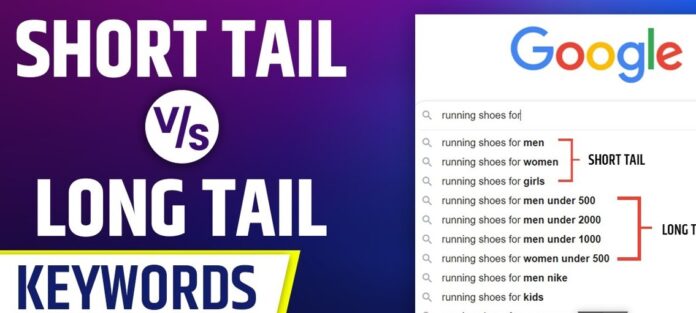Keyword optimisation is a cornerstone of digital marketing and Search Engine Optimisation. Keywords are words and phrases added to online content to improve how it ranks in Search Engine Results Pages (SERPs). These keywords fall into two main categories – “long-tail” and “short-tail”, and choosing appropriate keywords to target is vital to the success of your search engine rankings.
Short-tail keywords are broad, generic, popular terms of just a few words, which have high search volumes and competitive SERPs. Due to their broad nature, SERPs for short-tail keywords often include millions of results, making it difficult for businesses to rank on or anywhere near the first page.
Long-tail keywords, on the other hand, are specific, niche and highly targeted, with lower search volumes but comparatively lower ranking competition.
While ranking for short-tail keywords is the focus of many businesses’ SEO strategy, their long-tail counterparts typically receive less love. Businesses can rank highly for long-tail keywords much more easily by producing specific content that offers valuable and unique insights. This, in turn, provides increased exposure and an opportunity to improve brand authority.
Below are some of the primary advantages and disadvantages of targeting long-tail keywords as part of your SEO strategy.
Advantages
1. Increased Engagement

Long-tail keywords are associated with specific searches. Visitors searching these terms have typically already done some broad-level research, know a little bit about the topic and are now on the lookout for more specific and detailed information.
This makes them more receptive to messages and more likely to engage through ‘Likes’, comments and shares.
Focusing on particular long-tail keywords at times when they are most topical (e.g. when trending) will help to maximise traffic and engagement by piggybacking on higher levels of interest. This also makes content more shareable, which ultimately allows it to spread organically.
2. Better User Experience
Targeting long-tail keywords involves creating highly relevant content that provides genuine and valuable insight.
This type of content goes much further in providing visitors with the information they need, broadening their knowledge and helping them along their purchasing journey.
3. Improved Conversion

Visitors undertaking short-tail keyword searches are often in the early ‘fact-finding’ stage of their purchasing journey and are unlikely to make a commitment to buying.
With long-tail keywords, on the other hand, visitors have usually already done their broad research and have a good understanding of what they are looking for. At this stage, they are looking for specific information to determine whether your products and services meet their needs.
Providing this information will help them make a purchase decision and increase the likelihood that they convert into a paying customer.
4. Lower Competition
SEO is all about competition. For any keyword, there will be a multitude of businesses looking to rank as highly as possible. This is particularly true for short-tail keywords, where thousands of businesses are competing to rank for these broad, overarching, generalised terms.
Because long-tail keywords are more specific, there is less relevant content available and less competition for ranking. This provides a unique opportunity for marketers to get their content in front of a highly relevant target audience.
5. Niche Authority

Producing detailed and insightful content that targets long-tail keywords allows businesses to establish authority within specific niche topics.
If your business is one of just a few voices offering insight into a topic then visitors will naturally develop an association between your business and that topic. This can help your business become the ‘go-to’ source of trusted and credible information.
Disadvantages
While there are significant advantages to targeting long-tail keywords there are also some disadvantages that must be considered.
1. Less Traffic
Because long-tail keywords are concerned with specific topics, they have lower search volumes than their short-tail counterparts. This means that, while the audience seeing your content may be more relevant and engaged, there will ultimately be fewer of them.
2. More Time-Consuming
Targeting long-tail keywords requires detailed research. Firstly to identify which keywords to target then, once keywords are chosen, more research goes into understanding the topic, identifying any information gaps and carefully crafting valuable, insightful and high-quality content to fill those gaps; all of which requires substantial time investment.
3. Difficult to Scale
The reach, authority and association that comes with targeting long-tail keywords does not offer the same scalability as that of short-tail keywords.
Businesses with authority on broad topics can bank on that authority when discussing the various specifics however, businesses associated with more niche topics will often be pigeonholed and struggle to escape this association when discussing the broad-level topic.
4. Less Evergreen Content
Short-tail keywords are usually rooted in topics that aren’t time-sensitive, so audiences’ interest remains fairly consistent over time.
Long-tail keywords, however, are more susceptible to shifting trends which means that interest may fluctuate over time. When interest peaks, this is a good time to create content on a particular topic but, because interest levels will inevitably dip again, this content can be less valuable in the long run.
Conclusion

Like so many SEO debates, the discussion of short-tail vs. long-tail keywords hinges on quantity vs. quality. While short-tail keywords appeal to a large but generic audience, long-tail keywords appeal to a smaller but more targeted one.
Which of these audiences is more appealing will depend on your business objectives. Ultimately, a well-balanced strategy, targeting a combination of both long-tail and short-tail keywords, can help maximize your reach and engagement and attract a good variety of visitors at different stages of the purchasing journey.
Ross Pike, Marketing Director at leading exhibition stand contractor Quadrant2Design, shares his take: “Like most things in marketing, a consolidated approach works best for keyword targeting. By targeting a variety of both long-tail and short-tail keywords we can benefit from the advantages of both while simultaneously minimising their disadvantages”.
Creating the most effective balance between the two will require a thorough understanding of your business goals and objectives, as well as your specific industry and target audience. Using these factors, you can create an effective ratio that fully meets your business needs.









